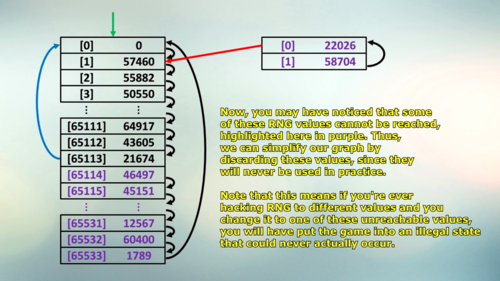RNG: Difference between revisions
(→Objects that call RNG: add more) |
|||
| Line 21: | Line 21: | ||
</nowiki> | </nowiki> | ||
===Description=== | ===Description=== | ||
The function | [[File:RNG Graph.png|500px|right|A graph showing notable RNG values and indeces in SM64.]] | ||
The function has 65536 possible inputs and 65536 possible outputs. It is a bijection, meaning that every input maps to exactly one output and none repeat or are left out. The function forms two loops, one of length 65534 and one of length 2, but one of the if statements causes the cycle of 2 to lead back to the cycle of 65534. Oddly, the RNG value of 21674 at index 65113 loops back to index 0. | |||
==Objects that call RNG== | ==Objects that call RNG== | ||
* [[Dust]] calls RNG to determine its resultant [[angle]] and [[horizontal speed]]. Note that the dust itself calls RNG, not the [[dust spawner]]. | * [[Dust]] calls RNG to determine its resultant [[angle]] and [[horizontal speed]]. Note that the dust itself calls RNG, not the [[dust spawner]]. | ||
Revision as of 23:46, 10 October 2018
RNG or Random Number Generation is the game's method of generating a random short. By doing this, the game can make things like dust movement seem random.
Technical description
The RNG variable is a short, which is a number from 0 to 65535 inclusive. When an object, snow, or something else wants to call RNG, it takes the current RNG value and runs it through the RNG function, below. It uses the result in its own calculations and also stores the result to the RNG variable. Thus, the RNG variable is equal to the last used RNG value.
The RNG function
unsigned short rng_function (unsigned short input) {
if (input == 0x560A) input = 0;
unsigned short S0 = (unsigned char)input << 8;
S0 = S0 ^ input;
input = ((S0 & 0xFF) << 8) | ((S0 & 0xFF00) >> 8);
S0 = ((unsigned char)S0 << 1) ^ input;
short S1 = (S0 >> 1) ^ 0xFF80;
if ((S0 & 1) == 0) {
if (S1 == 0xAA55) input = 0;
else input = S1 ^ 0x1FF4;
}
else input = S1 ^ 0x8180;
return (unsigned short)input;
}
Description
The function has 65536 possible inputs and 65536 possible outputs. It is a bijection, meaning that every input maps to exactly one output and none repeat or are left out. The function forms two loops, one of length 65534 and one of length 2, but one of the if statements causes the cycle of 2 to lead back to the cycle of 65534. Oddly, the RNG value of 21674 at index 65113 loops back to index 0.
Objects that call RNG
- Dust calls RNG to determine its resultant angle and horizontal speed. Note that the dust itself calls RNG, not the dust spawner.
- Goombas call RNG to determine which direction to move when they do not see Mario.
- Bob-ombs call RNG almost every frame to determine whether to blink.
- Although not an object, snow also calls RNG.
- Coins from Bob-ombs, Goombas, Big Cork Boxes, Cork Boxes, Piranha Plants, Bullies, Chuckyas, Fly Guys, Snowmen, etc... you name it, it calls RNG to determine angle, horizontal speed, and vertical speed.
